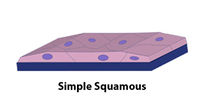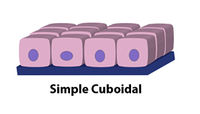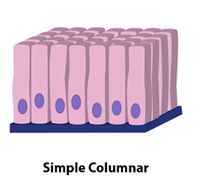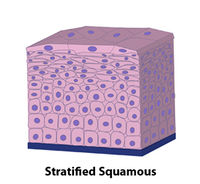Histologic:Chapter 3
Contents
- 1 Introduction
- 2 Simple Epithelium
- 3 Stratified Epithelium
Introduction
An epithelium is defined as a tissue that covers or lines the free surfaces of the body. It is one of four fundamental body tissues, with the other three basic tissues being muscle, nervous and connective tissues. Histologically, an epithelium is characterized as being composed of cells sitting upon a basement membrane. The cells are usually arranged in one or more layers with scant intercellular material, or they may sometimes be arranged in cords as in some endocrine glands.
One of the surfaces of an epithelium is exposed either to air or fluid, whereas the other surface is generally attached to a basement membrane that rests upon an underlying connective tissue. With rare exceptions, epithelium is not penetrated by blood vessels and must rely on diffusion processes from the underlying blood supply of the connective tissue for the exchange of nutrients, gases, and wastes (e.g., the endothelial lining of a blood vessel).
Epithelial tissues show numerous specializations of the free surface of cells or of the component cells themselves. For example, the glands of the skin and intestinal tract are derived from epithelium. The embryonic epithelium invaginates into the underlying connective tissue during embryonic development to differentiate into glandular structures. Remember that epithelial tissues are specialized to function in secretion, protection, excretion, absorption, lubrication, sensation, and even reproduction.
One should be able to classify any variety of epithelium according to its structure. An epithelium is usually named according to the appearance of the surface cells. The shape of the cells is important in naming the epithelium. Sometimes the shape referred to is the three dimensional one as in the case of squamous cells (scale-like) and sometimes the two dimensional appearance is referred to as it is seen when the cell is cut vertically to its base. Thus “cuboidal” cells which may appear as squares in sections are actually prismatic in shape with eight sides if seen in their entirety. “Columnar” cells are more elongated prisms. If a cell is surrounded and compressed equally on all sides by other cells, it is usually fourteen sided and appears as a polyhedron in a section.
Identify the following representative varieties of epithelial and be able to interpret the appearance even if it is not cut vertically to the basement membrane.
Simple Epithelium
This type of epithelium has one layer of cells.
Simple Squamous Epithelium
This “pavement epithelium” has flattened scale-like or plate-like cells.
Slide 118: Kidney (PASH)
On Slide 118, Kidney (PASH) locate the parietal layer of Bowman’s capsule surrounding the glomeruli (blood capillaries). Identify the layer of simple squamous epithelium which forms the parietal layer of Bowman’s capsule. These cells rest on a pink-staining basement membrane. Note that you can see only the nuclei clearly; the attenuated cytoplasm is indistinct.
Slide 18: Spleen (H&E)
On slide 18, Spleen (H&E), locate the connective tissue capsule that covers the spleen and note the simple squamous epithelium covering the capsule. This lining is called the mesothelium. A mesothelium is defined as a single layer of flattened cells forming an epithelium that lines serous (body) cavities. Note the shapes of the cells. In some regions, they may appear to be slightly cuboidal.
Simple Cuboidal Epithelium
In this kind of epthelium, the height of each component cell is approximately equivalent to its width.
Slide 114: Kidney (H&E)
On slide 114, Kidney (H&E), locate segments of kidney tubules lined with simple cuboidal epithelium. In this type of epithelium the nucleus is round and located in the center of the cell. Other segments of a kidney tubule may be lined by epithelial cells ranging from simple squamous to low columnar or pyramidal (modified columnar) in shape. On slide 118, Kidney (PASH) note how well the PAS stain demonstrates the basement membranes underlying the various epithelial. Cells of different heights are also readily observed on this slide.
Simple Columnar Epithelium
In this kind of epithelium, the height exceeds the width of the cell.
Slide 140: Duodenum (PASH)
On slide 140, duodenum, (PASH), observe the layer of columnar cells that cover the villi. The ovoid nuclei are located in the lower one-half of the cells. Study the shapes of the cells, the location of the nuclei and the specialization of the free surface. These columnar cells are absorptive cells that have microvilli forming a striated border and covered by a PAS-positive glycocalyx. Goblet cells, which are columnar cells modified to secrete mucus, can be seen interspersed among the absorptive columnar epithelial cells. The goblets in these cells exhibit heavy PAS staining.
Pseudostratified Epithelium
In this type of simple epithelium the nuclei of the cells appear in irregular layers and may give the false impression that the cells themselves are stratified. In a pseudostratified epithelium all the cells reach the basement membrane even though the nuclei lie at different levels in the tissue. Only the tall cells, however, reach the free surface.
Slide 2: Trachea (H&E)
On slide 2, Trachea (H&E), identify the pseudostratified columnar ciliated epithelium which lines the lumen of the trachea. Find an area where the epithelium is intact; it is torn off in places. The epithelium rests on a thick basement membrane. Scattered throughout the epithelium are numerous goblet cells that produce a mucous secretion that traps inspired particles. Study the position of the nuclei. Note once again the cilia of the tall cells of the pseudostratified columnar epithelium.
Slide 6: Epididymis (H&E)
On slide 6, Epididymis (H&E), is a section through the epididymis, a highly coiled genital duct of the male. The cross and oblique sections of this duct are the most numerous of the tubular structures on this slide. Study the pseudostratified columnar epithelium lining the lumen of the epididymis. Goblet cells and cilia are lacking and the basement membrane is not as prominent as it is for the epithelium of the trachea. Tall columnar cells with stereocilia are present. Smaller basal cells can be identified by observing their nuclei that are located close to the basement membrane.
Stratified Epithelium
This type of epithelium has more than one layer of cells present. The epithelium is named according to the shape of the surface cells even though the underlying cells may be a different shape. For example, if the surface cells are squamous, but the underlying cells are cuboidal or columnar, the epithelium is a stratified squamous epithelium.
Stratified Squamous Epithelium, Noncornified/Nonkeratinized (Moist)
On slide 131, Esophagus (H&E) identify the noncornified/nonkeratinized, stratified squamous epithelium. Note the flattened, nucleated surface cells, the “middle zone” of the polyhedral shaped cells, and the basal layer of the polyhedral shaped cells, and the basal layer of columnar cells which rests on the basement membrane. Characteristically, the lower surface of the epithelium is undulated.
Slide 131: Esophagus (H&E)
Stratified Squamous Epithelium, Cornified/Keratinized (Dry)
On slide 4, Thin skin (H&E) and Slide 46, Thick skin (H&E), study the representative types of cornified/keratinized, stratified squamous epithelium. Note the characteristics of the cells at the various levels. The surface layer of cells, represented by the stratum corneum of the epidermis, lacks nuclei and keratin proteins have replaced the cytoplasm. The surface cells of the skin are constantly desquamated. They are replenished by mitotic divisions occurring in the basal layer of epithelial cells. Note how much thicker the stratum corneum is for thick skin than for thin skin.
Slide 4: Thin Skin (H&E)
Slide 46: Thick Skin (H&E)
Stratified Cuboidal and Stratified Columnar Epithelium
On slide 111, Epiglottis (H&E), look in the connective tissue underlying the surface epithelium for ducts of glands lined with stratified cuboidal or stratified columnar epithelium. The surface epithelium of the epiglottis is an intermediate type where a change is being made from stratified squamous to pseudostratified columnar epithelium (some of the surface cells are torn off).
Slide 111: Epiglottis (H&E)
Transitional Epithelium
Transitional epithelium of the urinary passages and bladder shows variations in thickness according to the contracted or dilated state of the structure this epithelium lines. For example, in the contracted urinary bladder, the epithelium may be five or six cell layers thick with the surface cells appearing as large, cuboidal cells that bulge into the lumen. The basal cells are smaller than the surface cells and they interdigitate with the overlying cells. When the bladder fills with urine and becomes distended, the epithelium appears to be only two or three layers thick, and the surface cells are flattened.
On slide 121, Urinary bladder (H&E), identify the transitional epithelium and study its characteristics. Are any of the surface cells binucleated?
Slide 121: Urinary Bladder (H&E)
| ||||||||||||||||||||||||||||||||||||||||||||||||||||||||||||||



